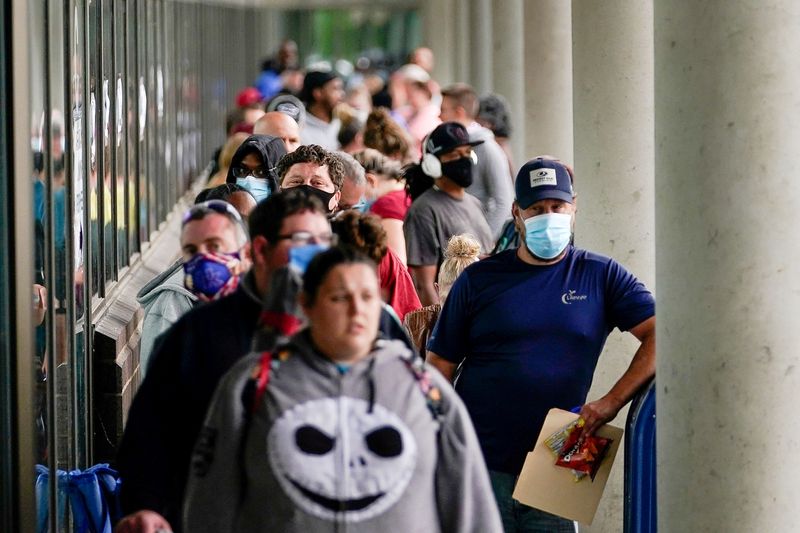By Lucia Mutikani
WASHINGTON (Reuters) - The number of Americans filing first-time claims for jobless benefits increased further last week, suggesting that an explosion in new COVID-19 infections and business restrictions were boosting layoffs and undermining the labor market recovery.
Still, the economy got off to a solid start in the fourth quarter, with consumer spending and business investment in equipment topping analysts' expectations in October. Businesses also reported a sharp rebound in profits in the third quarter.
But that is probably insufficient to lift the heavy cloud over the economy. Personal income dropped last month and could decline further with at least 12 million Americans due to lose government-funded unemployment benefits a day after Christmas.
The benefits, part of a more than $3 trillion government coronavirus relief package which has largely expired, helped contribute to record economic growth in the third quarter. Another package is expected only after President-elect Joe Biden is sworn in on Jan. 20. President Donald Trump is heavily focused on contesting his electoral loss to Biden.
"There is a two-tier recovery from the pandemic recession where the top of society continues to spend as normal while the bottom-half of the country sits in long lines at food banks with the opportunities for employment few and far between," said Chris Rupkey, chief economist at MUFG in New York.
Initial claims for state unemployment benefits increased 30,000 to a seasonally adjusted 778,000 for the week ended Nov. 21, the Labor Department said. That was the second straight weekly increase in claims and exceeded economists' expectations for 730,000 applications in a Reuters poll.
The weekly claims report, the most timely data on the economy's health, was published a day early because of Thursday's Thanksgiving Day holiday.
Unadjusted claims jumped 78,372 to 827,710 last week. Economists prefer the unadjusted number because of earlier difficulties adjusting the claims data for seasonal fluctuations due to the economic shock caused by the pandemic.
Including a government-funded program for the self-employed, gig workers and others who do not qualify for the regular state unemployment programs, 1.14 million people filed claims last week. There were at least 20.5 million people collecting unemployment benefits in early November.
The United States has been slammed by a fresh wave of coronavirus infections, with daily cases exceeding 100,000 since early November. More than 12 million people have been infected in the country, according to a Reuters tally of official data.
The respiratory illness has killed more than 259,000 Americans and hospitalizations are soaring, prompting state and local governments to reimpose a host of restrictions on social and economic life in recent weeks, which could keep claims above their 665,000 peak seen during the 2007-09 Great Recession.
Stocks on Wall Street were mostly lower. The dollar fell against a basket of currencies. U.S. Treasury prices rose.
EXHAUSTING BENEFITS
Though the claims report showed the number of people receiving benefits after an initial week of aid declined 299,000 to 6.071 million in the week ending Nov. 14, that was because many have exhausted their eligibility, which is limited to six months in most states.
A record 4.509 million workers filed for extended unemployment benefits in the week ending Nov. 7, up 132,437 from the prior week. These benefits as well as those for gig workers and the self-employed will lapse on Dec. 26.
That and the ebb in consumer confidence amid the raging pandemic cast doubts on the sustainability of the strong pace of spending. In second report, the Commerce Department said consumer spending, which accounts for more than two thirds of U.S. economic activity, rose 0.5% last month after increasing 1.2% in September. But personal income fell 0.7%, reversing a 0.7% gain in September. Economists had forecast consumer spending rising 0.4%.
"Were it not for recent virus-related developments, it looks like GDP would be on track for a pretty robust fourth quarter," said Daniel Silver, an economist at JPMorgan (NYSE:JPM) in New York. "But given the recent surge in new COVID-19 cases, we think that the data will soften noticeably in November and December."
The anticipated slowdown in consumer spending is likely to be blunted somewhat by solid business investment against the backdrop of robust profits, ensuring the economy continues to grow in the fourth quarter, though at a moderate pace.
Orders for non-defense capital goods excluding aircraft, a closely watched proxy for business spending plans rose 0.7% in October, the Commerce Department said in a third report.
A fourth report from the department showed after-tax profits without inventory valuation and capital consumption adjustment, which corresponds to S&P 500 profits, rebounded at a 36.6% annualized rate in the third quarter after two straight quarterly declines.
The department also confirmed that the economy grew at a historic 33.1% pace in the July-September quarter.
Growth estimates for the fourth quarter are below a 5% annualized rate. Slower growth was underscored by a fifth report from the Commerce Department showing the goods trade deficit increased 1.2% to $80.3 billion in October.

Despite encouraging developments on vaccines, spiraling COVID-19 infections and expectations for a smaller stimulus package have prompted economists to sharply downgrade their GDP growth forecasts for the first quarter of 2021.
